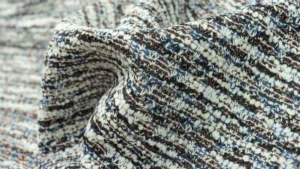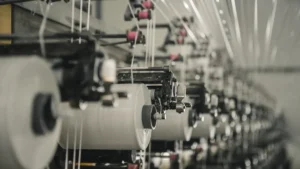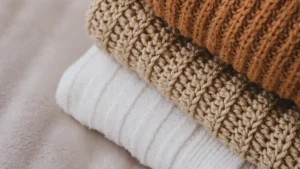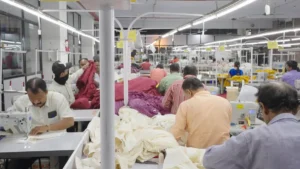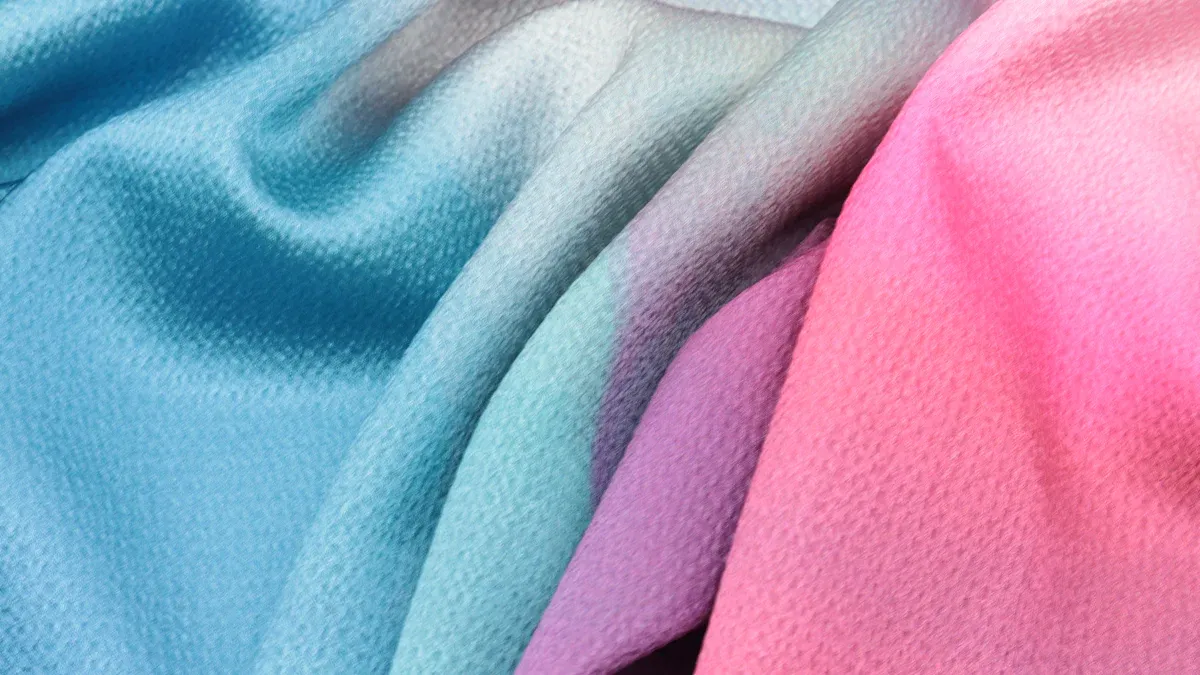
When searching for cotton knit fabric pink red wholesale, it’s important to consider several factors. Pay attention to the quality of the cotton knit fabric, the consistency of the pink and red colors, the specific type of knit, and the reliability of the wholesale supplier. Pricing and shipping options are also crucial. Always request samples or swatches of the cotton knit fabric pink red wholesale to check the true color and texture. Choose suppliers experienced in colored cotton knit fabric pink red wholesale, as they typically offer better quality and more dependable service.
Key Takeaways
Look at fiber content, weight, softness, and stretch to check fabric quality before you buy.
Always ask for samples so you can test color, texture, and how strong the fabric is. This helps you avoid surprises.
Pick the right knit type. Jersey is soft. Rib is stretchy. Interlock is smooth. Double knit is strong.
Choose suppliers you trust. They should have good reviews and certifications like GOTS. This helps make sure you get good quality and service.
Learn about prices, minimum order amounts, and shipping details. This helps you plan your purchase and avoid delays.
Fabric Quality
Fiber Content
When you pick cotton knit fabric in pink or red, check what fibers are used. Some fabrics are made with only cotton. Others mix cotton with polyester or rayon. Each type has its own features. Here is a table to help you compare:
Attribute | 100% Cotton | Cotton Blends (Tri-Blend: Cotton, Polyester, Rayon) |
|---|---|---|
Breathability | Very breathable and natural. Good for cool, dry places. | Not as breathable. Polyester keeps in heat and moisture. |
Durability | Can shrink, wrinkle, and fade. Loses shape and color over time. | Stronger and lasts longer. Does not tear, pill, shrink, or fade easily. |
Moisture-Wicking | Soaks up water but stays wet. | Dries fast and pulls moisture away because of polyester. |
Wrinkle Resistance | Gets wrinkled easily. | Does not wrinkle much. Easy to care for and no ironing needed. |
Color-Fastness | Color fades faster with washing and sun. | Keeps color bright after many washes. |
Softness | Feels soft and comfy. Natural touch. | Feels soft and smooth because of rayon and cotton. |
Flexibility | Not very stretchy. | More stretchy and bends easily because of rayon and polyester. |
Environmental Impact | Comes from plants and breaks down, but uses lots of water and chemicals to grow. | Not as good for the earth. Synthetic parts do not break down and can make microplastics. |
Always read the label or product info. Ask for a sample to touch and test the fabric.
Weight and Width
Fabric weight and width are important when buying wholesale. Weight is measured in grams per square meter (GSM). Most clothing knits are between 150 and 230 GSM. This range gives comfort and strength. Widths are usually 58 to 80 inches, which fits most rolls. Here is a quick guide:
Fabric Weight (GSM) | Fabric Width (inches) | Application Notes |
|---|---|---|
150 – 190 | 58 – 60 | Good for t-shirts, pants, and skirts |
210 | 80 | Used for heavier clothes |
230 | 60 | Great for strong, flowing clothes |
Ask for a fabric piece to check thickness and width before buying.
Stretch and Softness
You want your cotton knit fabric to feel soft and stretch well. Stretch comes from how the fabric is knitted or from added fibers like spandex. Softness depends on the cotton and blend. Touch a sample to see how it feels. Gently pull the fabric to see if it stretches and goes back to normal. Good fabric feels smooth and bounces back after stretching.
Durability
Durability means the fabric will last through many wears and washes. Wholesale sellers use tests to check this:
Pilling tests check if little balls form on the fabric.
Breaking and bursting tests measure how much force the fabric can take.
Dimensional stability tests show if the fabric shrinks or stretches after washing.
Tip: Always ask for a sample and test results. This helps you choose fabric that is strong and works well for your needs.
Color Factors
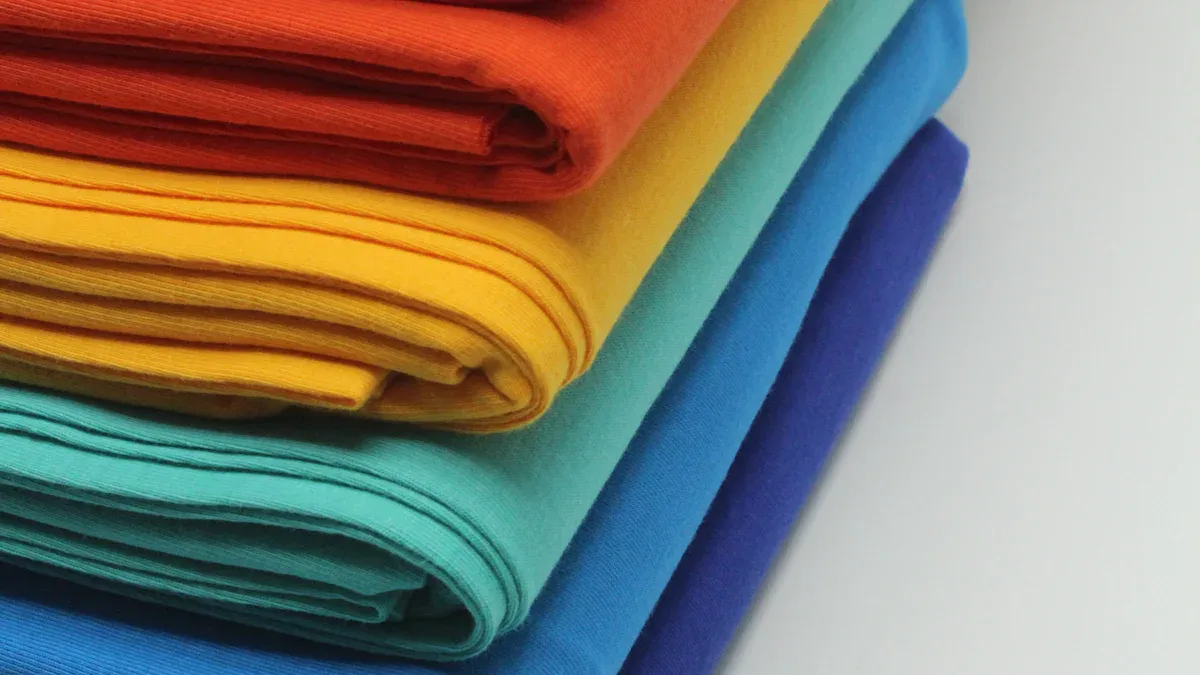
Colorfastness
Colorfastness tells you how well the pink or red color stays on your cotton knit fabric after washing, rubbing, or sunlight. You want your fabric to keep its bright color, not fade or bleed. To check colorfastness, you can ask your supplier for lab test results. The most common tests include:
Color fastness to rubbing (ISO 105 X12, AATCC 8)
Color fastness to light (ISO 105 B02, AATCC 16)
Color fastness to perspiration (ISO 105 E04, AATCC 15)
Color fastness to water (ISO 105 E01, AATCC 107)
These tests use special scales to measure color change and staining. You should always request a swatch and wash it at home. Rub it with a white cloth and leave it in sunlight for a day. This helps you see if the color stays strong.
Tip: Professional lab tests give the best results because they copy real-life conditions like sweat, sunlight, and washing.
Shade Consistency
Shade consistency means every yard of your pink or red fabric looks the same. In bulk orders, you may see streaks or lines called barre defects. These happen often because cotton from different places or seasons can mix together. Even small changes in fiber color or yarn can cause visible lines. Factories try to control this, but you should still check.
Always order a large swatch or sample from the same dye lot.
Lay out the fabric in good light and look for streaks or color changes.
Ask your supplier about their quality checks for shade consistency.
Note: Shade inconsistencies are common in bulk orders. Careful sampling and supplier checks help you avoid surprises.
Dye Quality
The dye process affects how bright and long-lasting your pink or red fabric will be. Fiber reactive dyes work best for cotton. These dyes bond with the cotton at a molecular level, giving deep, permanent color. They also resist fading from washing and sunlight. Natural dyes can make pink and red shades, but they need special steps like mordanting and careful temperature control. Natural dyes often fade faster and may not match from batch to batch.
Dye Type | Pros | Cons |
|---|---|---|
Fiber Reactive | Bright, permanent, colorfast | Synthetic, not always eco-friendly |
Natural | Eco-friendly, unique shades | Less stable, needs mordants, variable |
Always ask your supplier what dye process they use. For the most vibrant and lasting pink or red, fiber reactive dyes are the top choice.
Types of Knit
When you buy cotton knit fabric in pink or red, you will see different knit types. Each one has unique features that affect how your fabric looks, feels, and performs. Here is a quick guide to help you choose the right knit for your project:
Fabric Type | Construction | Characteristics | Best Uses | Performance / Behavior |
|---|---|---|---|---|
Jersey Knit | Single knit | Soft, stretchy, curls at edges | T-shirts, lightweight tops, dresses | Comfortable drape, holds prints well, curls at edges |
Rib Knit | Double knit (2 needle beds) | Vertical ribs, very elastic, shape-retentive | Cuffs, necklines, waistbands, sweaters, leggings | High elasticity, stretches widthwise, keeps shape |
Interlock Knit | Double knit (two interlaced jersey layers) | Thicker, smooth on both sides, stable, soft | High-quality t-shirts, dresses, sportswear | Durable, less curling, smooth, stable, polished look |
Double Knit | Two layers of knit fabric | Thick, stable, smooth on both sides | Dresses, jackets, skirts | Excellent shape retention, durable, less curling |
Jersey Knit
Jersey knit is the most common type you will find. It feels soft and lightweight. You can stretch it easily, which makes it perfect for t-shirts and casual dresses. Jersey knit drapes well and feels comfortable against your skin. The edges may curl, so you might need to hem them.
Tip: Jersey knit holds printed designs well. Choose this knit for everyday wear.
Interlock Knit
Interlock knit uses two layers of jersey knit that lock together. This makes the fabric thicker and smoother on both sides. You get a stable fabric that does not curl at the edges. Interlock knit feels soft and luxurious. It works well for baby clothes, sportswear, and high-quality t-shirts.
Rib Knit
Rib knit has raised vertical lines called ribs. You will notice it stretches more than other knits, especially across the width. Rib knit keeps its shape even after many wears. You often see it in cuffs, collars, waistbands, and fitted sweaters or leggings.
Rib knit is great for parts of clothing that need to stretch and return to shape.
It does not curl if made correctly.
Double Knit
Double knit fabrics use two layers of yarn, making them thick and stable. They feel smooth on both sides and do not curl. Double knits work best for structured garments like jackets, skirts, and dresses. These fabrics hold their shape well and last a long time.
Double knits cost more because they use more yarn, but you get extra durability and structure.
In summary:
Rib knit offers high elasticity for trims and fitted clothes.
Interlock knit provides stability and a smooth feel for quality garments.
Double knit delivers structure and durability for tailored pieces.
Cotton Knit Fabric Pink Red Wholesale
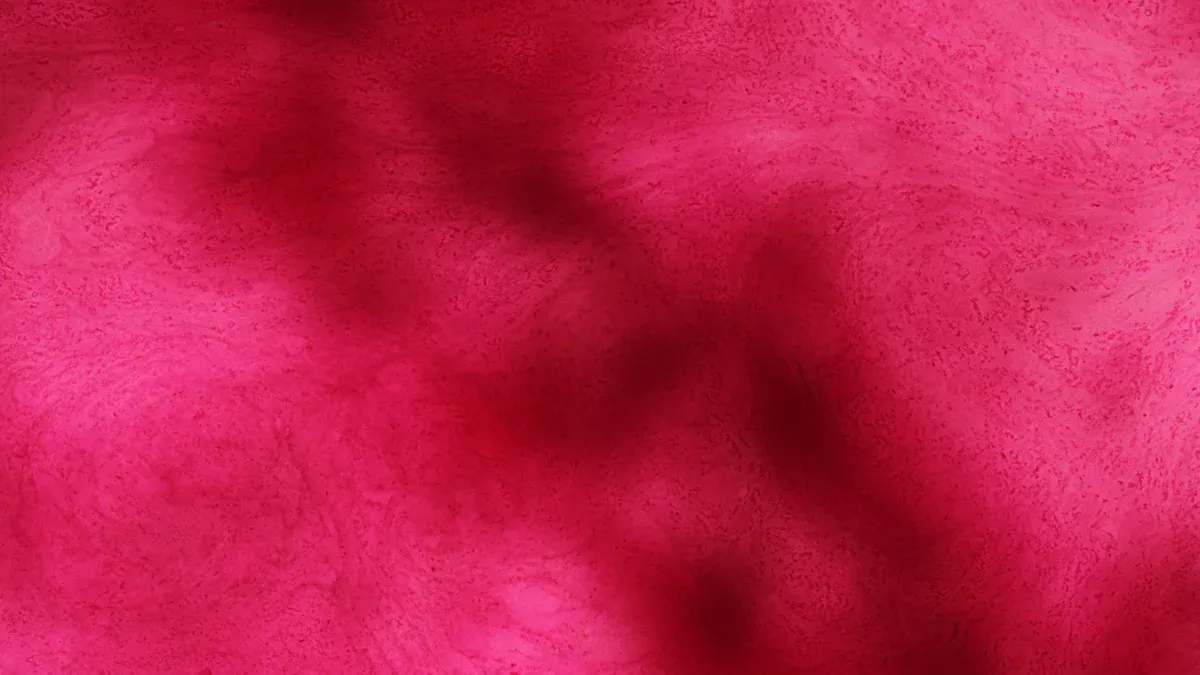
Supplier Selection
When you want to buy from a supplier, pick one you can trust. Look for suppliers who focus on colored knits. They know how to keep pink and red colors bright. Always check if they have certifications. The Global Organic Textile Standard (GOTS) is the top certification for colored cotton knit fabrics. GOTS covers organic farming, safe dyeing, and fair work conditions. Oeko-Tex and Organic Content Standard (OCS) are good too, but GOTS covers more.
To make sure a certificate is real, do these things: 1. Check the certificate for dates, license numbers, and who gave it. 2. Look up the supplier and certificate in the official GOTS or Oeko-Tex websites. 3. Scan any QR codes on the certificate. 4. If you are not sure, contact the certifying group.
Read reviews and ratings about the supplier. Good reviews mean the supplier gives quality fabric, ships on time, and helps if there are problems. Ask for samples before you buy a lot. This lets you check the color, feel, and stretch of the fabric. Good suppliers answer your questions fast and give clear details about their products.
Tip: Always get a sample and check the supplier’s certifications before you buy a lot.
Pricing and Minimums
When you buy cotton knit fabric pink red wholesale, compare prices and know the minimum order quantity (MOQ). MOQ is the smallest amount you must buy. Suppliers set MOQs to keep prices low and make production easier. If you buy more, you pay less for each yard. Here is a table with some common MOQs:
Supplier | Fabric Type | Minimum Order Quantity (MOQ) per Color |
|---|---|---|
Plakads Apparel | Cotton Single Jersey | |
Runtang | Chenille Knit |
Some MOQs are as low as 50 yards, others are up to 500 yards. Higher MOQs mean lower prices, but you need more space and money. Some sellers offer lower MOQs, which helps small brands save money.
When you look at prices, remember to add shipping costs. Shipping costs change based on where the supplier is. For example:
Region/Source | Shipping Costs Factors | Delivery Timelines | Additional Notes |
|---|---|---|---|
US-based suppliers | Free shipping if you spend enough; many warehouses | Fast delivery; some ship the same day | Many warehouses help ship quickly |
India & Bangladesh | Lower prices, but higher tariffs and longer waits | 45-60 days from Bangladesh | Tariffs and rules can slow down delivery |
Honduras | Duty-free under CAFTA-DR, fast shipping | 2-3 weeks | Good for US buyers because of trade deals |
Turkey (EU importers) | Duty relief on imports | Faster shipping | EU importers get benefits from trade deals |
Bangladesh | Lowest prices | Slower delivery | Tariffs and rules can cause delays |
Note: Always ask about shipping costs and delivery times before you order. This helps you plan your money and schedule.
Order and Delivery
Ordering cotton knit fabric pink red wholesale is easy if you follow some steps. Give your supplier clear details about the color you want. Use Pantone codes and send a color sample if you can. Do not use words like “brighter” or “a little more red.” Use clear color codes and terms. Put these details in your Bill of Materials (BOM) and tech packs.
Before you order a lot, always ask for a sample. Test the sample for color, stretch, and softness. This helps you make sure the fabric is right for you. When you order, check the supplier’s return policy. Most suppliers want you to check the fabric as soon as it arrives. You must tell them about problems within 72 hours or 10 days, depending on the supplier. You cannot return fabric that you have washed or cut. Small flaws or tiny color changes are usually not covered by return policies.
Here is a table with common reasons for returns or problems:
Reason for Returns/Disputes | Description/Details |
|---|---|
Inspection Requirement | Check and measure fabric when it arrives; report problems within 72 hours. |
No Refunds for Washed/Cut Fabric | No refund or exchange after you wash or cut the fabric. |
Flaws and Minor Imperfections | Small flaws (less than a quarter per yard) do not get a refund. |
Shortage Threshold | You can return only if fabric is short by 3 inches or more per yard. |
Buyer Error | No refunds if you order the wrong item. |
Return Shipping Costs | You pay return shipping unless it is the seller’s mistake. |
Return Time Limit | You must return fabric within 10 days of getting it. |
Final Sale Items | Sale and custom items cannot be returned or refunded. |
To get your order on time, pick suppliers with good shipping records. Suppliers in places with good roads and ports, like Guangdong, China, often ship faster. Stay in touch with your supplier. Ask for updates and track your order. Some buyers use third-party shipping companies to help with customs and delivery. You can also check if your shipping company has ISO 9001 certification or good reviews from other buyers.
Tip: Plan ahead and order early, especially if you need a lot or special colors. This helps you avoid delays and keeps your work on track.
If you follow these steps, buying cotton knit fabric pink red wholesale will be smooth and easy.
When you want to buy cotton knit fabric pink red wholesale, look at a few important things. Make sure the fabric is good quality. Check the color and the type of knit. Pick a supplier you can trust and think about how the fabric will be delivered. Here is a simple checklist to help you:
Look at the fiber content, weight, and how soft it feels.
Compare color samples to see if the shade and dye are good.
Pick the knit type that fits your project best.
Read what others say about the supplier and check their certifications.
Ask for samples or swatches to test the fabric’s quality, texture, and color. Samples let you see how the fabric feels, washes, and if it is right for you.
Samples help you know what you are getting and make better choices.
FAQ
What is the best way to check fabric color before buying?
You should always ask for a swatch or sample. Hold it in natural light to see the true color. Compare it to your color reference or Pantone code. This helps you avoid surprises.
How do I know if a supplier is reliable?
Read customer reviews and check for certifications like GOTS or Oeko-Tex. Ask questions and see how fast the supplier responds. Request samples to test their quality and service.
Can I return fabric if the color is not right?
Most suppliers let you return fabric only if you report problems quickly. Check the return policy before you buy. You cannot return fabric that you have washed or cut.
What is the difference between jersey knit and interlock knit?
Jersey knit feels soft and stretches easily. It works well for t-shirts. Interlock knit feels thicker and smoother on both sides. It does not curl at the edges and gives a polished look.
Why do minimum order quantities (MOQs) matter?
MOQs tell you the smallest amount you can buy. Lower MOQs help small businesses save money. Higher MOQs usually mean lower prices per yard. Always ask about MOQs before you order.



